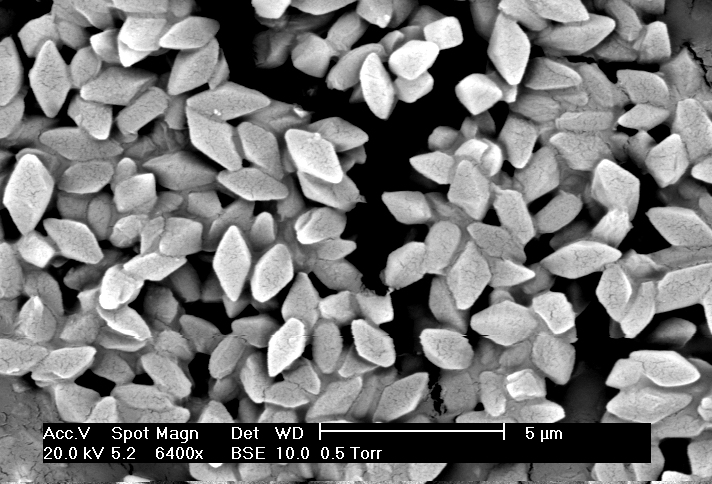Good things come in threes. The Good, The Bad, & The Ugly has three main characters and runs three hours, for example. Thus our series on pesticides marches onward into its third and final chapter. Good must always prevail, so we’ve dedicated this final installment to more pesticides that make the “good” list. The compounds listed here have been approved to use for cannabis in Oregon, California, Nevada, Colorado, and Washington.

Toxic crystals from Bt. Public domain.
- Bacillus thuringiensis: Bacillus thuringiensis, or Bt for short, is a soil-dwelling species of bacteria that creates toxic proteins in the form of crystals. Target herbivore larvae happily eat these up and die depending on the subspecies of Bt, the protein it produces, and the protein receptors in the target insect. According to Ibrahim et al [1], different subspecies have been developed to target “Hymenoptera, Homoptera, Orthoptera and Mallophaga as well as nematodes, mites and protozoa…” Bacillus thuringiensis kurstaki (Btk), for example, targets caterpillars (e.g., gypsy moth). Bacillus thuringiensis var. israelensis (Bti) targets the larvae of black flies and fungus gnats. Safety is high for mammals, birds, and other species with the inability to activate the toxic proteins. Some varieties of Bt produce β‐exotoxin, a secondary metabolite that is toxic to animals and humans; these are prohibited in the US and several other countries. [2]
- Rosemary oil: Rosemary oil boasts a dynamic team of active ingredients, such as carnosic acid, ursolic acid, caffeic acid, and rosmarinic acid. [3] An array of monoterpenes also play a significant role in insect toxicity, mainly 1,8-cineole but also α-pinene, β-pinene, camphor, and d-limonene. [3,4] Victims include mites, moths, aphids, and other soft-bodied insects. [4,5] On greenhouse tomato plants, for example, application of a pesticide with 10% rosemary oil was capable of reducing two-spotted spider mite population by half but did not affect beneficial predatory mites or plant health. [5] With direct toxicant effects, it also served as a temporary deterrent for about six hours. [5] As with most essential oils and terpenes, overexposure can be dangerous. However, rosemary oil is also a food (and apparently a hair growth treatment); the Environmental Protection Agency lists it as minimum risk.

Rosemary. Margalob: CC By-SA 4.0
Ultimately, pesticides may not be necessary. No consumer wants them, and they often incur at least some undesirable consequences. The best integrated pest management plans include beneficial insects, mechanical controls such as nets and pheromone traps, and proper crop management (e.g., pest-resistant cultivars, environmental monitoring/control, etc.).
References
- Ibrahim, Mohamed A, et al. “Bacillus thuringiensis: A Genomics and Proteomics Perspective.” Bioengineered,1, no.1, 2010, pp.31-50, doi:10.4161/bbug.1.1.10519. Impact Factor: 1.825; Times Cited: 85 (SemanticScholar)
- Palma, Leopoldo, et al. “Bacillus thuringiensis Toxins: An Overview of Their Biocidal Activity.” Toxins, 6, no.12, 2014, pp.3296-325, doi:10.3390/toxins6123296. Impact Factor: 3.273; Times Cited: 243 (ResearchGate)
- Akshay K, et al. “Rosmarinus officinalis: An Update Review of Its Phytochemistry and Biological Activity.” Journal of Drug Delivery and Therapeutics, vol.9, no.1, 2019. Impact Factor: N/A; Times Cited: 1 (ResearchGate)
- Isman MB, Wilson JA, Bradbury R. “Insecticidal Activities of Commercial Rosemary Oils (Rosmarinus officinalis.) Against Larvae of Pseudaletia unipuncta. and Trichoplusia ni. in Relation to Their Chemical Compositions.” Pharmaceutical Biology, vol.46, no.1-2, 2007, https://doi.org/10.1080/13880200701734661. Impact Factor: 1.241; Times Cited: 73 (ResearchGate)
- Miresmailli S, Isman MB. “Efficacy and Persistence of Rosemary Oil as an Acaricide against Twospotted Spider Mite (Acari: Tetranychidae) on Greenhouse Tomato.” Journal of Economic Entomology, vol.99, no.6, 2006, pp.2015-2023. Impact Factor: 1.779; Times Cited: 83 (ResearchGate)
Main Image: Public Domain








